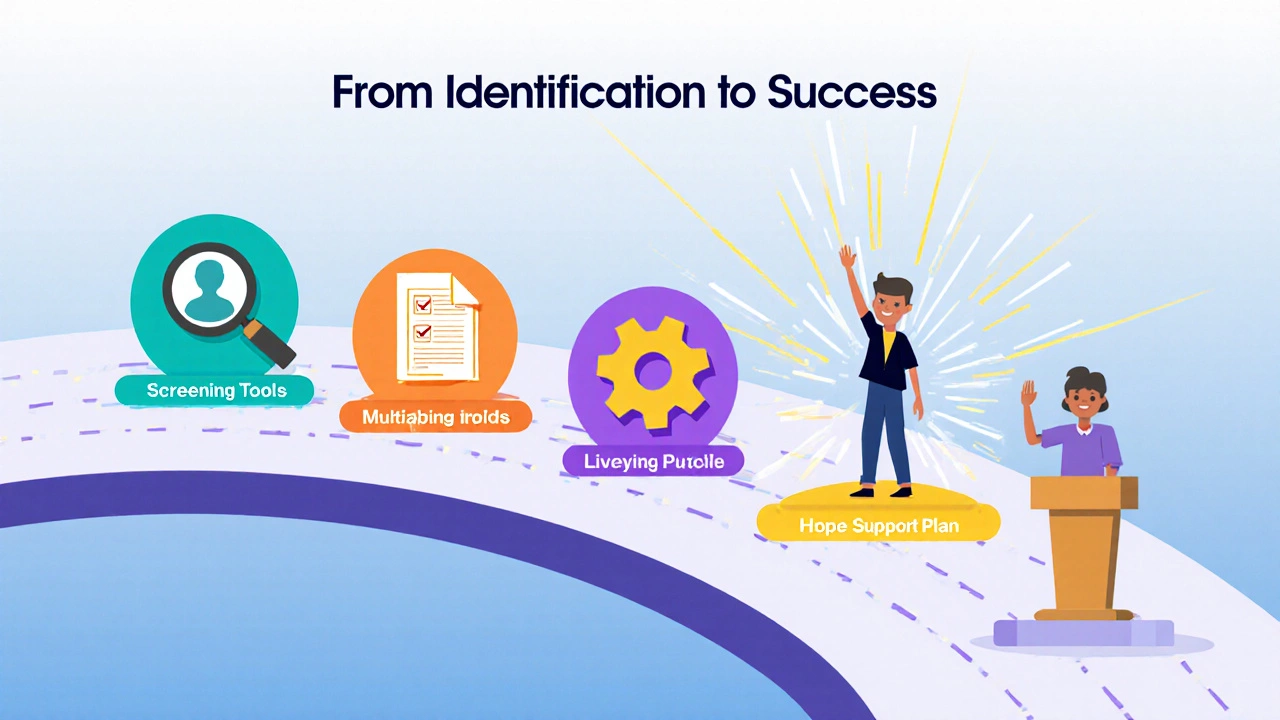SEN Observation Checklist
How to Use This Tool
This checklist helps you observe and track common signs of special educational needs across different domains. Rate each item based on how frequently you've observed it over the past 4 weeks.
- 0 = Never observed
- 1 = Rarely observed
- 2 = Sometimes observed
- 3 = Frequently observed
When you wonder whether a child or adult might need extra support in learning, the question often boils down to spotting special educational needs. It’s not about labeling; it’s about recognizing patterns that signal a person could benefit from tailored strategies, interventions, or legal protections. Below you’ll find practical ways to notice those signs, tools to track them, and steps to take when formal help is called for.
What Exactly Is "Special Educational Needs"?
Special Educational Needs (SEN) is a term used primarily in the UK to describe children and young people who require additional support because of learning difficulties, disabilities, or health conditions that affect their education. The definition extends to adults in further education or workplace training who face similar barriers.
SEN covers a broad spectrum-from mild dyslexia to profound intellectual disability. The common thread is that the standard curriculum or teaching methods alone aren’t enough for the learner to reach their potential.
Typical Signs Across Different Age Groups
Observing behavior, academic performance, and social interaction provides clues. While each condition looks unique, some red flags appear repeatedly:
- Consistent difficulty reading simple words despite regular practice.
- Struggles with following multi‑step instructions.
- Excessive anxiety or avoidance of classroom activities.
- Limited eye contact or unusual sensory responses.
- Frequent misunderstandings in social contexts.
Below is a quick comparison of how these signs manifest in common SEN categories.
| Need | Reading/Writing | Attention & Behaviour | Social Communication | Physical/Sensory |
|---|---|---|---|---|
| Autism Spectrum Disorder | Variable; may read well but miss nuances | Often hyperfocused on interests | Difficulty with reciprocal conversation, limited eye contact | Sensory sensitivities (noise, light) |
| ADHD | Frequent spelling errors, incomplete sentences | Impulsivity, restlessness, distractibility | May interrupt, struggles with turn‑taking | Generally typical; occasional motor coordination issues |
| Dyslexia | Slow decoding, letter reversals, poor spelling | May become frustrated, disengaged | Typical social skills unless compounded | None specific |
| Speech & Language Disorder | Difficulty with phonics, reading comprehension | May appear inattentive due to processing lag | Limited vocabulary, trouble forming sentences | None specific |
How Professionals Assess for SEN
The assessment journey typically starts with a screening-often a teacher‑filled questionnaire or an online checklist. If concerns persist, a more detailed Diagnostic Assessment is conducted by a multidisciplinary team that may include educational psychologists, speech therapists, and medical doctors.
Key components of a thorough assessment:
- Developmental history and medical background.
- Standardised academic tests (e.g., WISC, WIAT).
- Observations in classroom or natural settings.
- Parent/guardian interviews for contextual insights.
In England, the outcome may be an Education, Health and Care (EHC) plan, while other UK nations use an Individualised Education Plan (IEP). Both documents outline the learner’s strengths, identified needs, and the support that will be put in place.

Tools and Checklists You Can Use Right Now
If you’re a parent, teacher, or caregiver, you don’t need to wait for a formal assessment to start gathering useful data. The following tools help you track patterns over weeks or months:
- Observational Log: A simple table where you note date, setting, activity, what went well, and where difficulty arose.
- Behaviour Rating Scales (e.g., Conners’ Rating Scales for ADHD).
- Literacy Screening Packs such as the British Dyslexia Association’s Quick Screens.
- Speech Sound Checklists provided by Speech and Language Therapy Services.
Keeping a consistent record not only clarifies the picture for professionals but also empowers you to spot improvement after interventions.
When to Seek a Formal Assessment
There’s no exact formula, but consider moving to a formal evaluation if any of these conditions apply:
- Academic progress stalls despite additional tutoring.
- Behavioural concerns affect peer relationships daily.
- Parents or teachers notice the same patterns across multiple settings.
- Health professionals raise a flag (e.g., low vision, hearing loss).
In the UK, you can request an assessment through your local authority’s SEN team. The process typically involves a written request, followed by an initial meeting to discuss evidence and decide on the appropriate assessment pathway.

Creating a Support Plan That Works
Once a need is identified, the next step is translating that information into actionable support. A successful plan shares three qualities:
- Specificity: Clearly states what will be done, by whom, and when. Example - “Provide audio‑recorded lessons for maths, reviewed each Friday.”
- Measurability: Sets short‑term targets that can be tracked, such as “increase reading speed by 10 words per minute within six weeks.”
- Flexibility: Allows adjustments based on ongoing monitoring.
Collaboration is crucial. Teachers, parents, and the learner should meet regularly (often quarterly) to review outcomes and tweak strategies. Early intervention-intervening before the issue widens-has been proven to improve long‑term academic and social outcomes.
Common Pitfalls to Avoid
Even with the best intentions, certain missteps can stall progress:
- Waiting Too Long: Delaying assessment can embed gaps that become harder to close.
- One‑Size‑Fits‑All Solutions: A resource that works for dyslexia might not help a child with ADHD.
- Over‑Labeling: Some behaviours are age‑appropriate; premature labeling can affect self‑esteem.
- Neglecting Strengths: Focus solely on deficits; ignore talents that can be leveraged for learning.
Frequently Asked Questions
What is the difference between SEN and disability?
SEN refers to the additional educational support a learner needs, while disability is a broader legal term covering physical, mental, and sensory impairments. A person can have a disability without SEN if their condition doesn’t affect learning, and vice‑versa.
How long does a formal SEN assessment take?
The timeline varies by locality, but most UK local authorities aim to complete assessments within 12 weeks from the initial request, provided all needed information is submitted promptly.
Can adults receive an EHC plan?
Yes. While EHC plans are most common for children, adults with ongoing education, training, or employment needs can request a similar personalised support plan through their local authority or relevant service.
What role does the teacher play in identifying SEN?
Teachers are often the first to notice patterns because they observe learners daily. They document concerns, complete screening tools, and liaise with parents and specialists to initiate formal assessment.
Is a diagnosis necessary for an IEP?
An IEP can be created based on observed needs even without a formal medical diagnosis, especially in schools that follow a multi‑tiered system of supports. However, a diagnosis often strengthens the case for additional resources.
Recognising whether someone has special educational needs is a blend of observation, documentation, and collaboration. By staying alert to the signs, using the right tools, and acting promptly, you set the stage for tailored support that can make a real difference in learning and daily life.


Write a comment